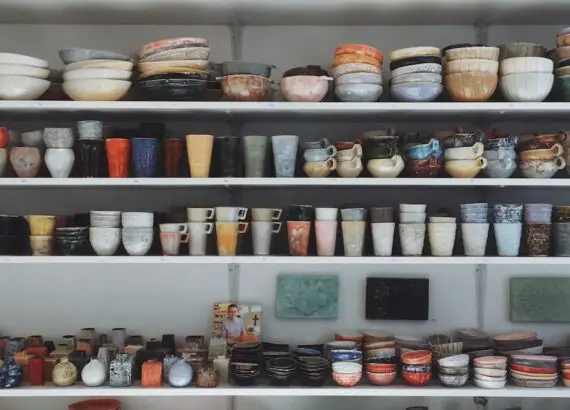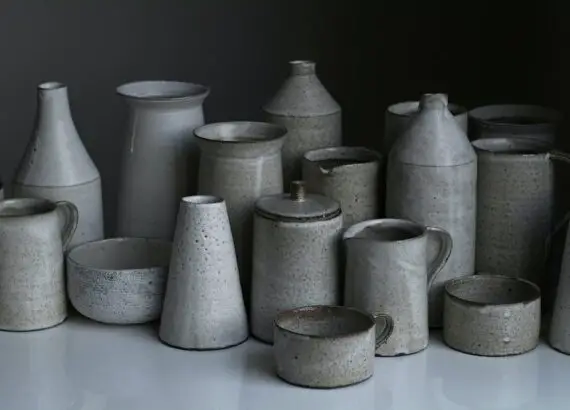Pottery Wheel History: How Was the Pottery Wheel Invented?
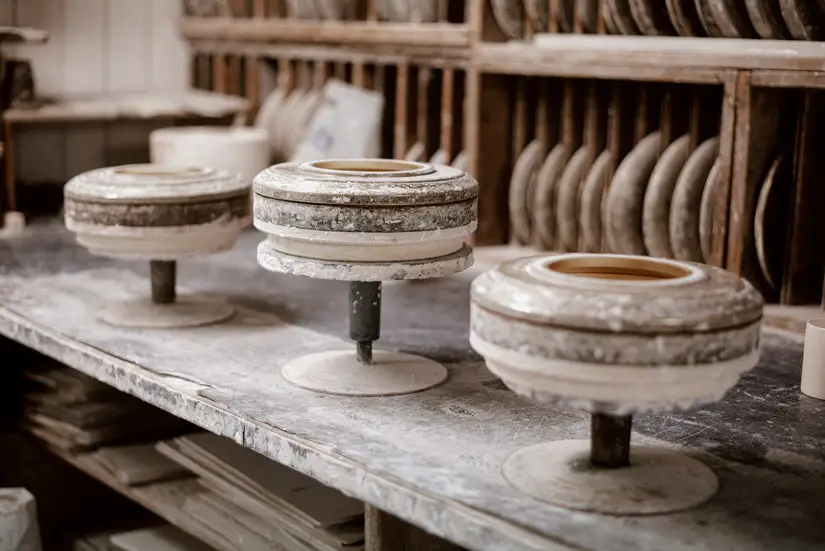
The origination of the pottery wheel probably started from the need for various sizes and types of pots. This is actually quite obvious because there would not have been any need to create a potters’ wheel without the urgent need for more pots.
At the beginning of civilization, there were different roles and responsibilities that people had to carry in order to continue the advancement of society as a whole. There was farming, hunting, cooking, and even trade by barter.
Definitely, at one point or the other, there was a need for vessels to assist in the daily duties and thus came about the need for pottery.
Table of Contents
Evolution of Humanity through the Lens of Pottery
Gradually humanity evolved and needed a more complex way of doing things that would result in more efficient and usable products. This translated into new and far more complex farming, hunting, cooking techniques; in fact, the evolution seeped into every aspect of human endeavor.
Cooking –and everything that related to meals as at that time was done using containers obtained from the art of pottery. Through pottery, bowls, dishes, jugs, and the likes were successfully made and utilized to their maximum capacity.

Nowadays, when people think of pottery, what comes to mind is a pottery wheel. But the mind-blowing thing is that even before the advent of the potters’ wheel, the art of pottery had long existed.
People made pottery without using a pottery wheel by using other methods such as;
- Coiling: It can be described as a method that allows one to be able to create huge and thicker vessels. This happens because the method allows perfect form when creating the vessel while it is gradually built up and it also allows one to build on top of the walls to give the pots a bigger look. It allows the pots to bulge outward or tend inward without the danger of collapsing altogether. In order to do this, the potter would take clay and then try to roll it in order to form a coil afterwards the clay would be placed on each other and thus, different things can be formed with the clay.
- Pinching: This is a technique that is done by pressing the thumb into a ball of clay and then drawing out the clay into a pot by continuously squeezing the clay between the thumb and fingers.
- Paddling: This technique involves the gentle and tender patting of a hard vessel with a wooden tool known as the paddle. In addition to shaping the vessel, paddling also helps in the compression of the clay at the vessel’s surface, which adds to the vessel’s strength and stability. This is more of an altering method because it is used to make changes to already molded pottery without causing any problems.
These methods of making pots were known as handmade pottery. As compared to using the pottery wheel, the handmade method gave off a natural feel that some people actually prefer over the wheel method.
How the Pottery Wheel Was Invented?
The oldest form of the potter’s wheel would have most likely been developed as an extension to the handmade procedure.
At that time, it was known as tourneys or slow wheels. Tourettes, which was in use around 4500 BC in the Near East, were turned slowly using the hand or foot when the coiling process was being used to make a pot.
Only a small range of vessels was made using the tournette, implying that it was actually used by only a limited number of potters. Despite this fact, the introduction of this slow wheel definitely improved the efficiency of handmade pottery production.
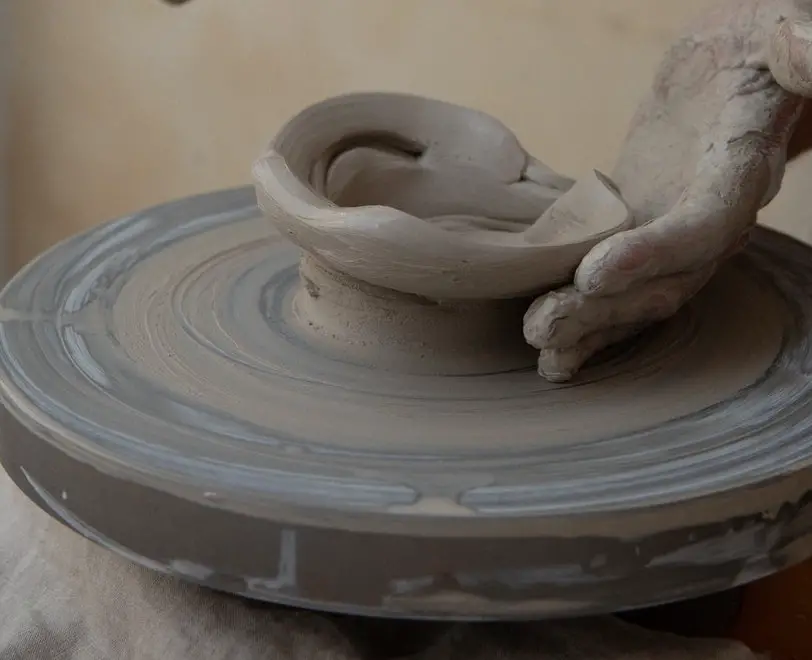
It was in the mid to late third millennium BC that the fast wheel was finally developed. It operated on the flywheel principle. It used the energy that was stored in the rotating mass of the heavy stone wheel to speed up the whole pottery-making process.
The wheel would be wound up and charged with energy by kicking it and pushing it around with a stick, thus providing a centrifugal force. This method was able to create a new process of pottery-making that was known as throwing. In this method, a lump of clay would be placed centrally on the wheel, and then it would be squeezed, lifted, and shaped as the wheel was turning.
This process leaves rings on the pot’s insides, and it excels at creating thinner-walled vessels and wider types of shapes. This was actually the first major step towards industrialization because potters could now produce a whole lot more pots than they were used to.
When was the Potter’s Wheel Invented?
Many modern scholars suggest that the first real potter’s wheel was developed by the ancient Sumerians that lived in Mesopotamia.
There had been findings of a stone potter’s wheel at the Sumerian city of Ur, which is modern-day Iraq. The findings have actually been dated back to about 3129 BC, but even still, there have also been fragments and pieces of some wheel-thrown pottery that was found at an earlier date in the same area.
Despite this evidence, southeastern Europe and China have also been mentioned as probable places of origin. The potter’s wheel was also in really popular use by the potters around the 3500 BC period in major cities of South Asia like Harappa and Mohenjo-Daro.
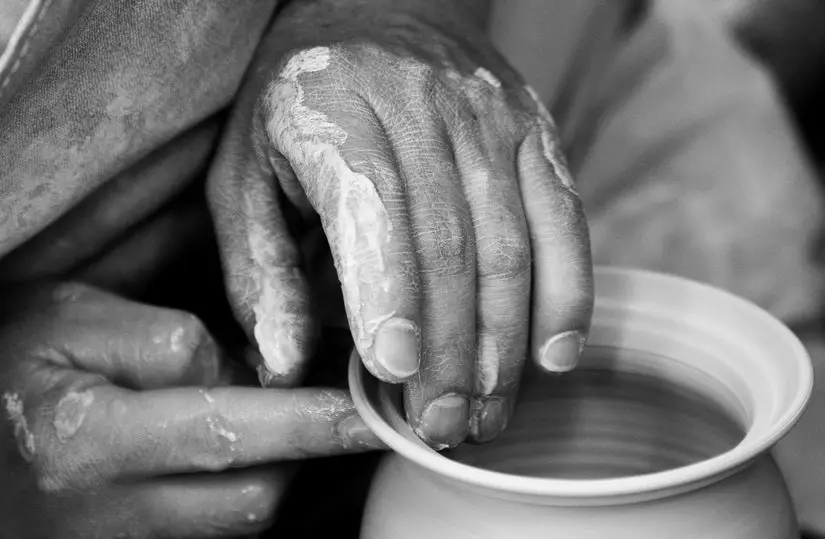
There are also whispers about Egypt being the actual place of origin of the potter’s wheel. It was in this place that the flywheel was added, and the turntable shaft was also lengthened. This was actually around 3000 BC.
The flywheel was operated through a kicking motion which was later changed to pulling the edge with one’s left hand while one forms the clay with the right hand. This is what led to the motion of the potter’s wheel, which is counter-clockwise even to this day. So, all in all, the exact origin of the potter’s wheel is not exactly clear yet.
Which Antique Nations Used the Potter’s Wheel
Due to the fact that the potter’s wheel made industrialization possible, a whole lot of old civilizations made use of the pottery wheel. In fact, the pottery wheel saw widespread use throughout the Old World. Some of the antique nations that made use of the pottery wheel are;
- Sumerians
- Chinese
- Egyptians
- Greeks
- Byzantine
- Romans
- Persians
The main reason the pottery wheel had so much influence and hold on these nations is how it was able to keep up with the demand in civilizations worldwide. It helped them move on with industrialization as cities gradually tripled in size and demands increased over and over.
Despite the fact that the pottery wheel turned up in Africa, Asia, and Europe, it still remained invisible in the Americas until the presence of the Spaniards in 1492. Even today, some of these traditional Native American ceramics artists do not use the pottery wheel as a method of respect for their traditions.
What Centuries was the Potter’s Wheel used in?
The potter’s wheel was majorly used at the beginning of the third phase of the Early Bronze Age, at about 2400 BCE. Pottery cannot be done by hand modeling or coiling without the potter either turning the vessel or moving around it, and, as turning it involves the smallest exertion of human effort, it would definitely be preferred.
The development of the slow wheel as help to pottery manufacture gradually led to the introduction of the kick wheel, which was rotated by foot.
By the 18th Century, the wheel was no longer turned by using the potter’s foot but done by small boys who were apprenticed to the potter.
Then since the 19th Century, the motive power has turned mechanical. The first evidence of the presence of the potter’s wheel was found in Egyptian paintings.
Pottery in Egypt was a really skilled craft in the Early Bronze Age. Potters were revered members of society. Probably the most skillful of all potters have been the Chinese. Some excellent examples of their skill are the double-gourd vases made from the 16th Century onward, which were turned into separate sections and joined together.
Mythology Based on the Pottery Wheel
A whole lot of cultures created mythologies that were actually built around the idea of the pottery wheel. This is definitely a signal of how really influential it is. In ancient Egypt, the god known as Khnum, which was the ram-headed god of fertility, was always shown at the pottery wheel.
The god Khnum was said to have shaped humans from the clay of the River Nile. He was said to have molded heaven and earth at the pottery wheel.
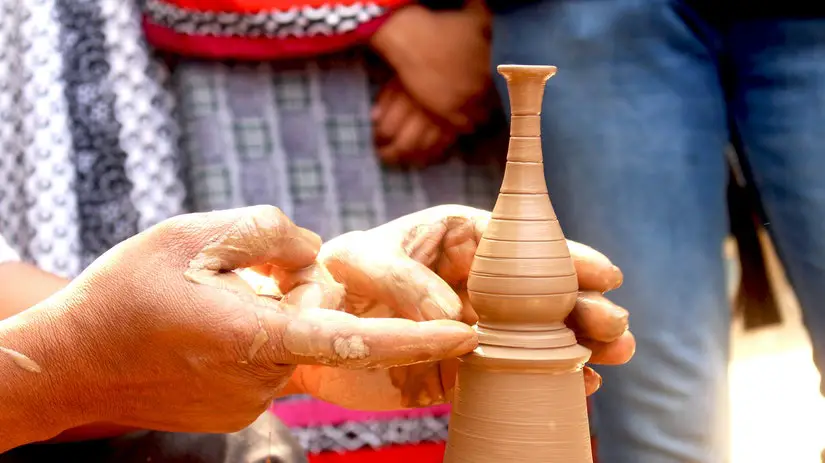
Many historians typically argue that the pottery wheel was the most meaningful piece of technology in ancient Egypt, and it came second only to the lever. Another part of the reason for this came from how it inspired the movement towards more advanced technologies.
In spite of the popularity of the pottery wheel during this period, no one really knows where the wheel actually came from. It is uncertain if it came from ancient Egypt. Also, the invention of the actual wheel would always debate which civilization invented it. Actually, the most evidence points to the Sumerians, but then there is also a possibility that it might have come from several civilizations.
However, there is the fact that everyone must agree on, that despite not being invented there, the pottery wheel actually first emerged in Egypt during the Old Kingdom period, which was also known as the Age of Pyramids during 3000 BC.
How Does the 16th Century Pottery Wheel Differ from the 19th Century Wheel?
The major difference between the 16th-century wheel and that of the 19th-century wheel comes from the materials that were used for making them. Pottery wheels that were used in the 19th Century were made of iron and steel rods with greased metal bearings.
Now to compare that with the wheels of the 16th Century, you would notice that most of those pottery wheels were made of wood with greased leather. They were made to use a metal point with a glass socket that could be found at the bottom of the wheel.
The only difference between the pottery wheel that was made in China and in Japan and the pottery wheel that came from the West came from how China and Japan did not have a raised seat with their pottery wheel.
In the Westside, people would actually sit in a raised seat to do pottery. Typically, the eastern pottery wheel turned clockwise and used the left hand, while the pottery wheel in the Westside turned counterclockwise and used the right hand. In Hinduism, just like Islam and Christianity, they typically view the use of the left hand as a taboo.
The First Cultures to Make Use of the Pottery Wheel
Usually, archaeologists say that the Sumerians of the now modern-day southern Iraq were the first to make use of the pottery wheel, but then there are other early cultures that also used it, which includes; the Egyptians, the Chinese, the Greeks, and the Indus Valley Civilization.
The pottery wheel might have begun in Sumeria, but it quickly became commonplace everywhere in the Old World because it impacted all societies wherever it went.
A good way to understand it is to think of how almost all cultures across the world have finally adopted computers. Literally, every country in the world has computers because of the convenience it brings.
Even in the countries that have low computer ownership, like Bangladesh (5%), Pakistan (8%), and Indonesia (11%), one would still be able to find computers, and the rate of computer ownership in these countries would only keep increasing. The exact thing could be said of the pottery wheel as when its technology began to spread in those civilizations.
Literally, everyone started using the pottery wheel because they were able to manufacture pots and vessels much faster, which then enabled them to meet their ever-pressing demand. Across Europe, the pottery wheel transitioned into major use around 1000 BC. Almost all cultures eventually started using the pottery wheel because it enabled them to cause a beneficial change in their societies through the mass production of vessels and pots.
How the Fast Wheel and Slow Wheel Differed?
The concept of the fast wheel and the slow wheel is something that intrigues a lot of people. It would be really nice to be able to know the specific difference between the both of them.
The fast wheel actually arrived after potters started the technological advancement with the slow wheel. It then lasted for about a century before most of the potters living in Europe and Asia then moved on to the fast wheel.
The slow wheel was constructed in a way that made use of a simple moving platform. On the other hand, the fast wheel actually used a very similar platform to the slow wheel, but then it spun on an axle, which was similar to what someone would see on a toy top.
The fast wheel was like cutting-edge technology for that time because of how quickly it enabled potters to produce the same work very easily and was also able to make vessels a lot faster than before.
Even the apprentices stationed at the wheel can produce at least between three hundred to four hundred cups per day at the wheel in some places. This should give a vivid idea of how much the wheels helped in the mass production of pottery.
Aegean Civilizations and the Fast Pottery Wheel
As at the time that the fast pottery wheel was brought to Crete during the Early Bronze Age, which was about 3000 BC to 1200 BC, it arrived around the same period it did on the mainland and in the Cyclades. At the period of its emergence, Cretan pottery was going through a revolution.
During this period, the finer vases were made using paints that were dark and shiny. The most prevalent colors that were used were black, red, and brown. This type of pottery was rampant in Crete from 2200 BC to 1600 BC.
There were movies based on the culture that also depicted pottery in those designs, typically black and red vases. Athens was a city in particular that actually became famous for the Greek style of pottery.
Other known sites boast of the traditional pottery wheel on the Greek peninsula, including ancient Corinth and ancient Athens. The Greeks, in particular, had a strong reputation for their unique vases.
Did the Pottery Wheel Lead to the Invention of the Wheel?
Many archaeologists do not actually believe that the wheel started out as a mechanical component used in the making of chariots.
There are pieces of evidence that lead to the idea that the wheel would have first started off as a potter’s wheel. Apart from the fact that the invention of the pottery wheel brought about the mass production of pots, it also inspired the wheel’s usage for things like chariots.
A whole lot of unique technologies were realized from the pottery wheel because of what it inspired later on.
The Relationship Between Kilns and Pottery Wheels
When one is making mention of the development of the pottery wheel, one has to understand how it did not develop just on its own. Gradually as the traditional wheel continued to become better, advancements were also made on the kiln too.
The earliest kilns worked through a mechanism of a bonfire from a hole in the ground, and it was commonly known as Pit Pottery. Over the years, technology has taken great strides and became even more complex than it ever was.
This is important and worth talking about because the way ceramics get fired will definitely impact how the piece of the vessel will look or feel. There are three types of kilns in our modern world; wood, gas, and electric.
Wood Kilns
They have been the longest in use. People have used wood kilns for thousands of years. The main problem that one faces when using a wood kiln is the intense effort one has to put in before everything works properly. The potter must always ensure he or she keeps stoking and adding fuel to the fire to ensure the temperature remains high.
There is also the disadvantage that the wood kiln also takes almost as much as double the time gas or electric kiln would use, and that is why a lot of potters nowadays would not use it. One unique advantage of this method is that the ash that lands on the pottery creates its own glaze, so few potters still use it because of that.
Gas Kilns
Gas kilns always keep out oxygen during firing, and this factor makes the gas kiln highly unpredictable and also likely to cause mixed results. Despite this fact, a couple of potters would still pick the gas kiln because of its rich and earthy colors.
The major issue with gas kilns is how difficult it is to maintain consistency.
Electric kilns
Electric kilns are the newest and also cheapest option when it comes to pottery. These characteristics are probably why it is the most common method used. The end results of this method tend to better than all the rest because it is fired at the oxidation stage, which then leads to a consistent structure throughout the oxidation stage. No one knows exactly when electric kilns were first invented, but their usage goes as far back as 1949.
Conclusion
From the moment the potter’s wheel emerged in Sumeria, it has helped change pottery’s scope for good. It gradually evolved and grew from a basic wheel to a powerful electric wheel.
The truth is that the art of pottery has always existed but just evolved from one form to another, but the invention of the potter’s wheel really helped to make industrialization possible.

